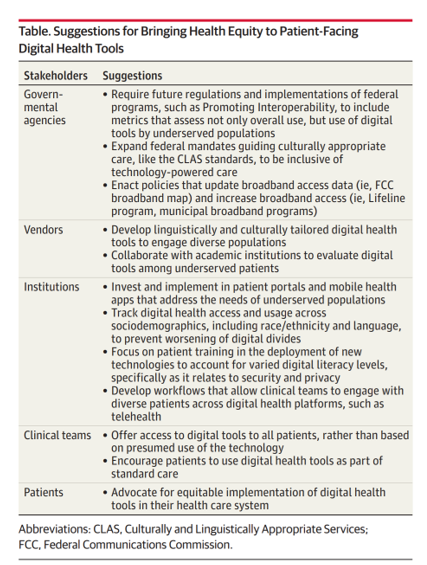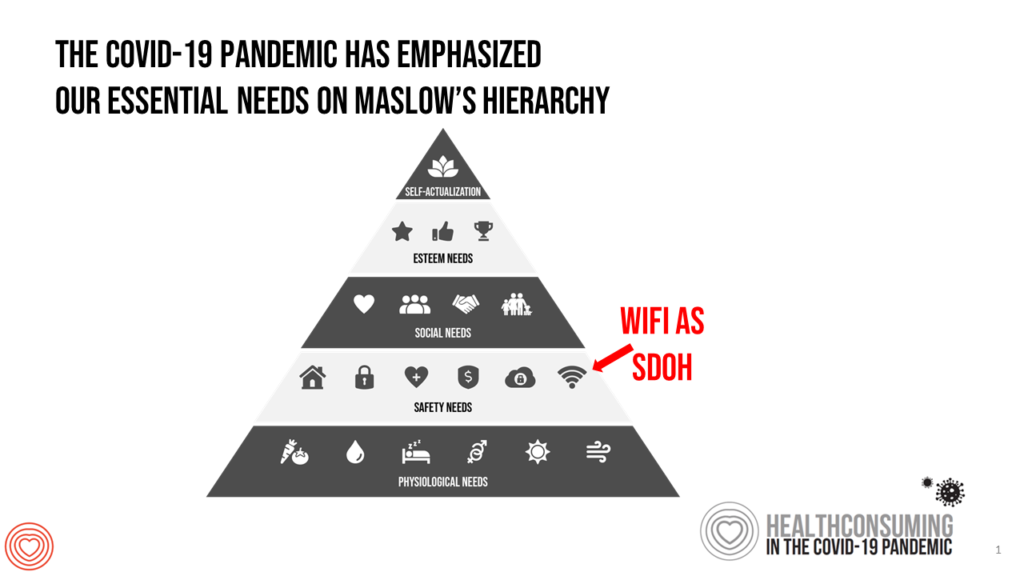The 21st Century Cures Act emphasizes patients’ control of personal health information. ONC rules issues in March 2020 called for more patient-facing health tools and apps to bolster health consumer engagement and empowerment.
But the emergence of the coronavirus in the U.S. revealed many weakness in the American health care system, one of which has been health inequities faced by millions of people — especially black Americans, who have sustained higher rates morbidity and mortality for COVID-19.
There have also been digital health divides found in the COVID-19 pandemic, discussed in a timely essay in JAMA, Digital Health Equity as a Necessity int he 21st Century Cures Act Era.

Three physicians from Brigham and Women’s Hospital, part of Harvard Medical School, cite three pillars that underpin digital health inequity in America:
- Technology access barriers,
- Digital health literacy, and
- Lack of inclusive design.
We’ve attested for years that broadband is a social determinant of health and daily living, but 21 million people lack access in the U.S., the authors call out. In addition, beyond connectivity, many people lack the hardware necessary to access the Internet — namely, smartphones and tablets. Ironically, people who are mobile-first consumers tend to be from racial and ethnic minorities.
“Closing digital divides necessitates not only technology access, but also supporting patients’ use of these digital tools,” the authors assert. Digital literacy combines with health literacy to bolster patient engagement. But while the new ONC rules may make it easier for health consumers to access personal health information, the Field of Dreams phenomenon subverts the noble goal: we may “build” a system for people to access health data (like Blue Button), but patients may not “come.” That is, actually access the system.
Finally, the third issue long overlooked in health care technology: user-centered design, and especially “inclusive” design. User-centered design compels us to understand health consumers, patients and caregivers like any successful consumer-goods company would do — to think like Steve Jobs, or Disney, or Procter & Gamble, in deeply empathizing with the folks who will use our products and services (or apps or portals) and understand their life-flows, values, ethnic and social mores, language, and indeed, digital barriers.
How to deal? The chart details some of the authors’ recommendations, which cross organizational siloes and require collaboration. There’s a mix of public sector tactics, from Federal to State to local; technology vendor tasks; health care provider jobs to do in terms of workflows and database development; and, patient-focused work.
By being inclusive, the authors conclude, we’ll get closer to the promise of increasing patients’ access to data and, ultimately, enhance health equity.
 Health Populi’s Hot Points: As the U.S. continues to recognize and wrestle with equity for all health citizens, digital equity, beyond a pure healthcare play, has a key role.
Health Populi’s Hot Points: As the U.S. continues to recognize and wrestle with equity for all health citizens, digital equity, beyond a pure healthcare play, has a key role.
We’ve learned in the COVID-19 #StayHome journey that school-aged children and college students needed access to (1) a hardware device like a computer or tablet, and (2) Internet connectivity, to continue attending school classes outside of the brick-and-mortar classroom. Teachers have been working diligently to extend their curriculum to students at home, at a distance.
But many students lacked access to either or both the physical technology and the data plan-on-ramp to the Internet.
This, too, was a challenge for people who needed health care at home, to avoid contact to avoid the risk of being exposed to the virus. The great growth of telehealth will be a success story to be written in the coronavirus history books some day, but the virtual care opportunities from the consumer/patient side of that interaction were limited to those patients who could access those services with a broadband connection or other form of cellular connectivity.
My Maslow Hierarchy diagram here includes WiFi as a social determinant — on the level of a safety need, and also applicable to basic physiological needs. This is now broadly accepted given our mass-shared experience of the pandemic. Let’s make sure to bake in digital equity as we re-build an American that’s more equitable for all people like clean air and water, safe streets, and justice for all.




 Interviewed live on BNN Bloomberg (Canada) on the market for GLP-1 drugs for weight loss and their impact on both the health care system and consumer goods and services -- notably, food, nutrition, retail health, gyms, and other sectors.
Interviewed live on BNN Bloomberg (Canada) on the market for GLP-1 drugs for weight loss and their impact on both the health care system and consumer goods and services -- notably, food, nutrition, retail health, gyms, and other sectors. Thank you, Feedspot, for
Thank you, Feedspot, for  As you may know, I have been splitting work- and living-time between the U.S. and the E.U., most recently living in and working from Brussels. In the month of September 2024, I'll be splitting time between London and other parts of the U.K., and Italy where I'll be working with clients on consumer health, self-care and home care focused on food-as-medicine, digital health, business and scenario planning for the future...
As you may know, I have been splitting work- and living-time between the U.S. and the E.U., most recently living in and working from Brussels. In the month of September 2024, I'll be splitting time between London and other parts of the U.K., and Italy where I'll be working with clients on consumer health, self-care and home care focused on food-as-medicine, digital health, business and scenario planning for the future...